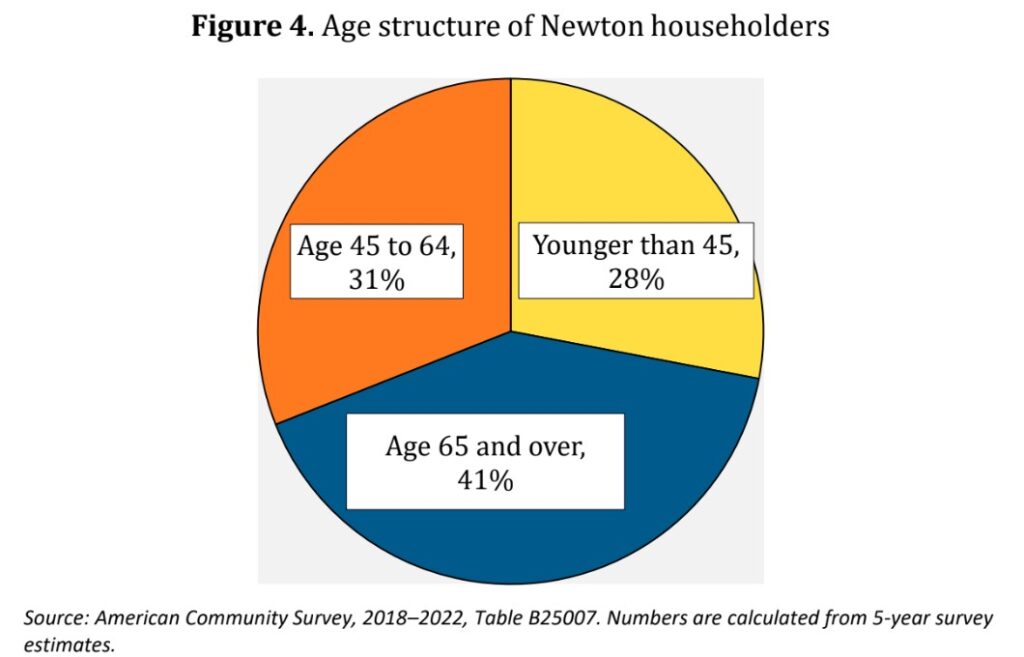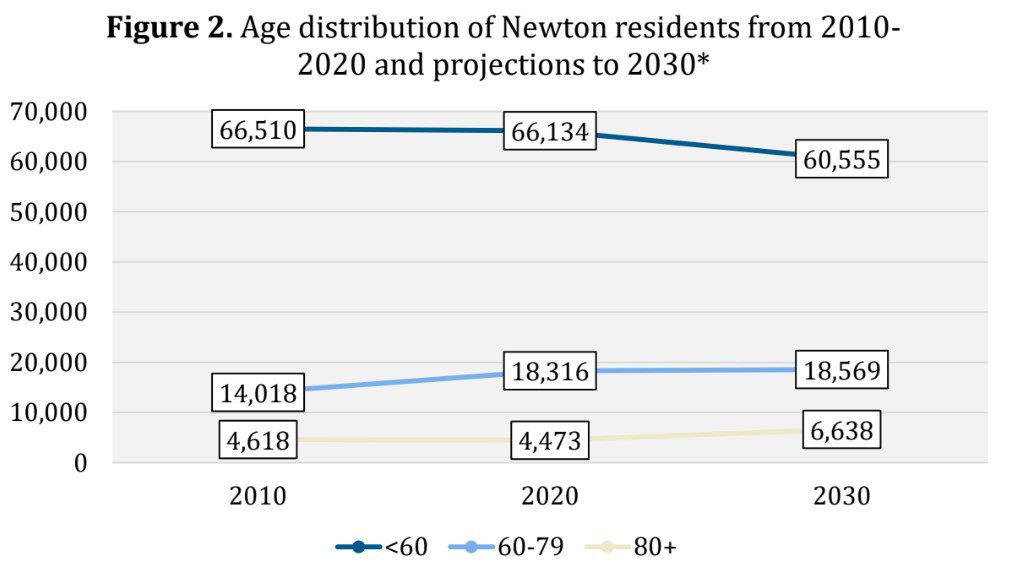Cooper1
Audrey Cooper's family join local officials in the groundbreaking ceremony for the Cooper Active Living Center, Photo by Bryan McGonigle
PHOTO: Audrey Cooper’s family joins local officials in the groundbreaking ceremony for the Cooper Active Living Center in May 2024. Photo by Bryan McGonigle
It’s estimated that in just a few years, almost a third of Newton’s entire population will be over age 60.
The city commissioned an extensive analysis and report on its population age trends from the Gerontology Institute at UMass Boston, and that report has been released. What it shows is a city getting older as seniors live longer, more active lives and young adults find it more and more difficult to afford homes in the area.
And that has Newton officials focused on how to plan for an older yet vibrant population in Greater Boston.
Titled “Aging in Newton: A Community Needs Assessment,” the report details trends in various age groups in Newton both past and present as well as forecasts for the age demographic makeup of the city in the future, to assess what the city will need for its senior population in the years to come.
“The focus areas of this report are broad and deep,” Mayor Ruthanne Fuller wrote in the document’s introduction. “They include outdoor spaces and public buildings; transportation options; diversity and social inclusion; communication and public information; housing choices; social participation; civic participation and employment; as well as community and mental & physical health services.”
The report, Fuller added, is also helping the city determine ways to help the senior population thrive and to help plan for the new Cooper Center for Active Living, set to open in late 2025.

Some highlights
According to the report, about 39 percent of the city’s population—almost four in 10 residents of Newton—are aged 50 and older. And about a quarter of its residents are aged 60 and over. And by 2030, 30 percent of the population will be 60 or older.
Between 2010 and 2020, two age groups—under 60 and over 80—stayed somewhat the same, while the number of residents between ages 60 and 79 increased. And projections for 2020 to 2030 have the under-60 group decreasing and both the 60 to 79 and over-80 groups increasing in numbers.
“We’re at about 22,000 residents who are over the age of 60,” Mignonne Murray, director of the city’s Department of Older Adult Services, said. “And beyond that, what was interesting to me, there’s another 12,000 residents who are between 50 and 59. So it’s obviously a greatly growing population. And we want to do the best we can for them.”
If the older groups reach a combined 30 percent by 2030, that will mean 25,000 residents over age 60.
This follows trends elsewhere in Greater Boston, as COVID-19 made remote work more common and young adults have left the region for more affordable living elsewhere.
And while older adults have age in common, their circumstances and needs vary. So the report breaks down those numbers, and Mignonne said that is helping her and city officials plan for the city’s future as well as plan what the new Cooper Center will offer.
A deeper dive into the report, for example, shows that 52 percent of residents older than 65 are renters, while 30 percent own their homes.
And 22 percent of Newtonians over age 65 live alone, while 75 percent live in households with other people and three percent live in group quarters.
Almost 60 percent of respondents, including 71 percent of residents aged 80 and older, said they want to stay in Newton.
Almost a third (32 percent) said they have lived in Newton for more than 45 years, while just 12 percent said they moved to the city fewer than 15 years ago.
Murray said the survey helps assess priorities and needs of this growing older population. Many respondents, for example, said they wanted to see extended hours offered at the Cooper Center and more transportation opportunities throughout the city.
And with fixed incomes and a rising cost of living, financial insecurity is an ongoing problem for Newton’s older residents.
“We see it directly with our case manager and the people she helps on a day-to-day basis, but I think that will come as a surprise to some folks,” she said.
The housing crunch has exacerbated that. Seniors who have lived in buildings for decades, who now face eviction because the building owners are selling, are often unable to find housing they can afford. And for senior homeowners, the more demand there is for housing, the higher property values raise, and that comes with higher property taxes.

‘Age-friendly movement’
More seniors in the city means more need for walkable neighborhoods and village centers. Fortunately, the city has kept that in mind while addressing infrastructure improvements.
“The city, since several years before my time here, has gone to the age-friendly movement, and a lot of that work has been infrastructure and making sure age is thought of in multiple departments,” Murray said. “My department and the Planning Department work very closely on transportation, not just for Go-Go—which is our transportation system now—but also about Blue Bikes access and how people can get to the Cooper Center and other places.”
And there’s the Newtonville commuter rail station, which Fuller and Newton’s state legislators spent years pushing for. That project has finally been given the green light with state and federal government funds helping.
To say that station lacks accessibility is an understatement. Even for young, able-bodied people, those stairs down to that platform can be treacherous.
When the Newtonville station project is done, it will be fully accessible to seniors and people with mobility challenges, allowing easy travel to Boston for doctor appointments, shopping, dinner and a play, and much more.
Putting the ‘active’ in active living
It’s one thing to live a long life. But what about really living?
Indeed, the Cooper Center for Active Living has the word “active” in it because it reflects a new generation of older adults. The days of gathering to play cribbage have been replaced with days of hitting the pickleball courts and riding bicycles through the city.
The 32,000-square-foot Cooper Center is named after the late Audrey Cooper, who worked for many years for Newton Public Schools. It’s set to open in late 2025 and will have a gymnasium with a suspended walking track, a game room, fitness rooms, activity spaces, an outdoor roof deck and more to keep seniors and their friends active and part of the community.
And Murray said the data in the “Aging in Newton” report will help the city plan for not just an older population but an active older population, and one that thrives with other generations in the city. That’s why the Cooper Center will be available for use by people of all ages.
“Older adults are part of the community, and the community is part of older adults,” Murray said. “And I don’t think anyone thinks of themselves differently as they age. They’re just at an older age, you can have people who are 50 with health that’s much worse than someone who’s 80. Age is relative.”
Murray added that the needs assessment of the “Aging in Newton” report is ongoing. She plans to visit with older residents in the spring to gather more information about what people want and need as the Cooper Center construction moves toward its finish line. She’ll also be talking with officials in other departments to coordinate efforts with that needs assessment.
“We can’t all do it alone. It’s a large community with tons of resources and people who want to help,” she said.
You can read the entire “Aging in Newton” report below.